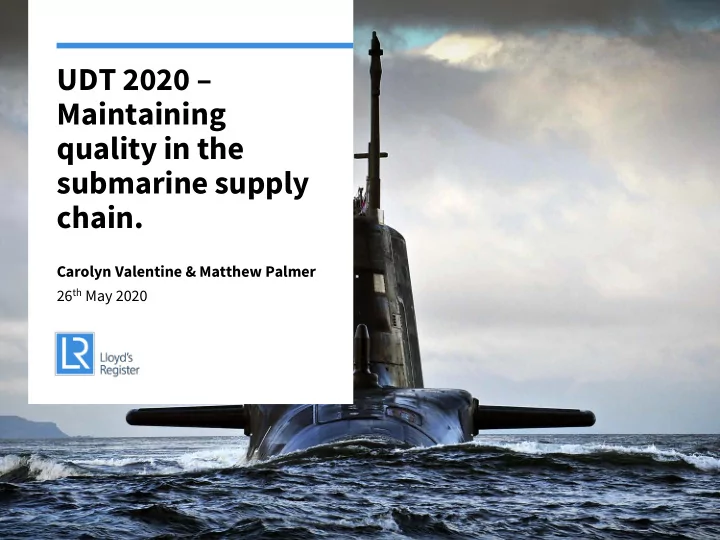

UDT 2020 – Maintaining quality in the submarine supply chain. Carolyn Valentine & Matthew Palmer 26 th May 2020
Introduction ● Background of the submarine supply chain ● Management of Transverse issues ● Potential problems in the submarine supply chain ● Can we use the principles from the ship supply chain? ● Level of assurance based on safety function Lloyd's Register 2
Submarine supply chain Builder/maintainer design teams input Comms Submarine builder/maintainer Site team ITP Supplier Assurance Verify Supplier ITP Purchase ITP Order Comms Visit Report Independent third party Kick Off verification (optional) Lloyd's Register
Basic Differences (Transverse issuses) • Stealth Power • Submarines Stability • Closed Atmosphere • Defect Tolerance • Weight Watchers • System Integration Lloyd's Register 4
What are the potential problems in the submarine supply chain ● Local vs global ● Long lead items ‘lock out’ ● Maintain the design ● Limited supply chain and bespoke items ● Spares ● Record keeping Lloyd's Register 5
Surface ship supply chain and its application for submarines ● Developed over many years ● Ship Rules demanded by industry to protect assets ● Built on vast a knowledge & experience base ● Classification Society Rules work across the shipping industry ● Readily adopted by naval ships • Share common features • Similar compliance demands • Exist in large numbers so good knowledge & experience base • Resource pressure on standards Lloyd's Register 6
Surface ship supply chain and its application for submarines ● Compliance with prescriptive standards doesn’t address every safety risk. ● Ship standards set minimum safety requirements. ● Whole boat transverse requirements are derived from the ConOpS. ● Transverse whole boat issues apply to every design level. ● Higher quality requirements depending on risk category. • Ship standard with modifications or additions is an acknowledgement the rule does not in itself address the requirements. • This approach can provide cost effective solutions for the designer. Lloyd's Register 7
Level of assurance bases on safety function ● How and where the material/component is used? ● Consequence of failure ● Safety function could be broken down by hazard: – Structure – Watertight integrity – Buoyancy and control – Propulsion – Power generation and distribution Lloyd's Register 8
Manufacturing Risk Safety Function (i) Pressure Hull Valve Strength & WT Safety Function (c) Safety Function (c) Integrity Pipe Pipe Manoeuvring & Control Manoeuvring & Control • Supplier Performance Risk Consequence of Material Failure Catastroph • Novel Process Critical Significant Marginal Negligible ic Likelihood Likelihood Fatalities per Event per Annum • Product Complexity 10 -1 to >10 -2 >10 10 to >1 1 to >10 -1 <10 -2 • Product Value Frequent >1 Probable 1 to >10 -1 • Programme Critical 10 -1 to >10 -2 Occasional • Common Mode Failure 10 -2 to >10 -3 Remote 10 -3 to >10 -4 Improbable 10 -4 to 10 -5 Highly Improbable Safety Function (i) Safety Function (i) Pressure Hull Back Incredible <10 -5 Pressure Hull Back Up Up Valve Valve Strength & WT Safety Function (c) Safety Function (c) Safety Function (p) Strength & WT Integrity Integrity Compressed Air System Compressed Air System Pipe Clips Manoeuvring & Control Manoeuvring & Control Power & Propulsion Lloyd's Register
Level of assurance based on safety function Materials System Pressure Hull Valve Rules for Materials Pressure and Piping System components Approved Works • Testing Procedures • Performance Requirements • Copper Alloys • Construction and Installation • Corrosion Prevention • Trim and Compensating System • Sea Water Cooling Systems • System Testing, Integration and • Trials Transverse Whole Boat Component Transverse Pressure and Piping System • Survivability components • Product Verification • Categorisation Performance Requirements • • Assessment • Materials • Copper and copper alloy piping • Functions components Valves • Watertight integrity Testing • Lloyd's Register
System & Component Risk Combinations Lloyd's Register
Risk based approach Safety case ● Traditional – Inflexible – Assumes everything works as new – Is difficult to run ‘what ifs’ ● Goal Based – Flexible – Allows for manipulation at lowest level – Can be extended if circumstances change – Copes with multiple degradation of systems – More easily updated Lloyd's Register 12
Summary Consequence of failure drive higher build quality • Supplied product is the foundation of build quality • Product & Build Quality key to through life reliability & availability • Quality cannot be INSPECTED into a product • Quality can be BUILT into the product • SQEP Independent verification provides Assurance • Verification supported by well defined solutions • Solutions that reflect product risk category • Lloyd's Register
Thank you Carolyn Valentine & Matthew Palmer LR Submarine Programme Manager Naval Centre of Expertise 2 nd Floor, The Sion, Crown Place, Nailsea Bristol BS48 1RB T +44 (0) 1275 515000 M +44 (0) 7764430644 E roger.coles@lr.org www.lr.org/marine Lloyd's Register 14
Recommend
More recommend